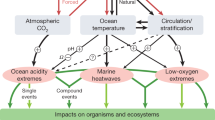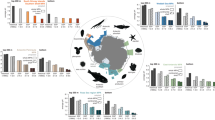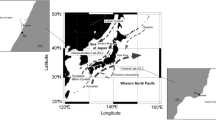Abstract
The pH of the surface ocean is changing as a result of increases in atmospheric carbon dioxide (CO2), and there are concerns about potential impacts of lower pH and associated alterations in seawater carbonate chemistry on the biogeochemical processes in the ocean. However, it is important to place these changes within the context of pH in the present-day ocean, which is not constant; it varies systematically with season, depth and along productivity gradients. Yet this natural variability in pH has rarely been considered in assessments of the effect of ocean acidification on marine microbes. Surface pH can change as a consequence of microbial utilization and production of carbon dioxide, and to a lesser extent other microbially mediated processes such as nitrification. Useful comparisons can be made with microbes in other aquatic environments that readily accommodate very large and rapid pH change. For example, in many freshwater lakes, pH changes that are orders of magnitude greater than those projected for the twenty second century oceans can occur over periods of hours. Marine and freshwater assemblages have always experienced variable pH conditions. Therefore, an appropriate null hypothesis may be, until evidence is obtained to the contrary, that major biogeochemical processes in the oceans other than calcification will not be fundamentally different under future higher CO2/lower pH conditions.
Similar content being viewed by others
Log in or create a free account to read this content
Gain free access to this article, as well as selected content from this journal and more on nature.com
or
References
Allen EJ, Nelson EW . (1910). On the artificial culture of marine plankton organisms. J Mar Biol Assoc UK 8: 421–474.
Atkins WRG . (1922). The hydrogen ion concentration of sea water in its biological relation. J Mar Biol Assoc UK 12: 717–771.
Beman JM, Chow CE, Popp BN, Fuhrman JA, Feng Y, Hutchins DA . (2009). Alteration of oceanic nitrification under elevated carbon dioxide concentrations. Paper abstract, ASLO Aquatic Sciences Meeting, Nice, France, January 25–30, 2009 (http://www.aslo.org/meetings/nice2009/files.html).
Booth IR . (1985). Regulation of cytoplasmic pH in bacteria. Microbiol Rev 49: 359–378.
Boyd PW, Doney SC, Strzepek R, Dusenberry J, Lindsay K, Fung I . (2008). Climate-mediated changes to mixed-layer properties in the Southern Ocean: assessing the phytoplankton response. Biogeosciences 5: 847–864.
Brewer PG, Peltzer ET . (2009). Limits to marine life. Science 324: 347–348.
Caldeira K, Wickett ME . (2003). Anthropogenic carbon and ocean pH. Nature 425: 365.
Collins S, Bell G . (2004). Phenotypic consequences of 1000 generations of selection at elevated CO2 in a green alga. Nature 431: 566–569.
Delille B, Harlay J, Zondervan I, Jacquet S, Chou L, Wollast R et al. (2005). Response of primary production and calcification to changes of CO2 during experimental blooms of the coccolithophorid Emiliania huxleyi. Global Biogeochem Cycles 19: GB2023.
DeLong EF, Preston CM, Mincer T, Rich V, Hallam SJ, Frigaard NU . et al. (2006). Community genomics among stratified microbial assemblages in the ocean's interior. Science 311: 296–503.
Doney SC, Abbott MR, Cullen JJ, Karl DM, Rothstein L . (2004). From genes to ecosystems: the ocean's new frontier. Frontiers Ecol Environ 2: 457–466.
Doney SC, Fabry VJ, Feely RA, Kleypas JA . (2009). Ocean acidification: the other CO2 problem. Annu Rev Mar Sci 1: 169–192.
Dore JE, Lukas R, Sadler DW, Church MJ, Karl DM . (2009). Physical and biogeochemical modulation of ocean acidification in the central North Pacific. Proc Natl Acad Sci 106: 12235–12240.
Egge JK, Thingstad TF, Larsen A, Engel A, Wohlers J, Bellerby RGJ et al. (2009). Primary production during nutrient-induced blooms at elevated CO2 concentrations. Biogeosciences 6: 877–885.
Fabry VJ, Seibel BA, Feely RA, Orr JC . (2008). Impacts of ocean acidification on marine fauna and ecosystem processes. ICES J Mar Sci 65: 414–432.
Field KG, Gordon D, Wright T, Rapp M, Urbach E, Vergin K et al. (1997). Diversity and depth-specific distribution of SAR11 cluster rRNA genes from marine planktonic bacteria. Appl Environ Microbiol 63: 63–70.
Fu F-X, Warner ME, Zhang Y, Feng Y, Hutchins DA . (2007). Effects of increased temperature and CO2 on photosynthesis, growth and elemental ratios of marine Synechococcus and Prochlorococcus (cyanobacteria). J Phycol 43: 485–496.
Gilbert JA, Field D, Huang Y, Edwards R, Li W, Gilna P et al. (2008). Detection of large numbers of novel sequences in the metatranscriptomes of complex marine microbial communities. PLoS One 3: e3042.
Grossart H-P, Allgaier M, Passow U, Riebesell U . (2006). Testing the effect of CO2 concentration on the dynamics of marine heterotrophic bacterioplankton. Limnol Oceanogr 51: 1–11.
Hopkins FE, Turner SM, Nightingale PD, Steinke M, Bakker D, Liss PS . (2010). Ocean acidification and marine trace gas emissions. Proc Natl Acad Sci 107: 760–765.
Huesemann MH, Skillman AD, Crecelius EA . (2002). The inhibition of marine nitrification by ocean disposal of carbon dioxide. Marine Pollution Bulletin 44: 142–148.
Hutchins DA, Fu F-X, Zhang Y, Warner ME, Feng Y, Portune K et al. (2007). CO2 control of Trichodesmium N2 fixation, photosynthesis, growth rates, and elemental ratios: implications for past, present, and future ocean biogeochemistry. Limnol Oceanogr 52: 1293–1304.
Hutchins DA, Mulholland MR, Fu FX . (2009). Nutrient cycles and marine microbes in a CO2-enriched ocean. Oceanography 22: 128–145.
Iglesias-Rodriguez MD, Halloran PR, Rickaby REM, Hall IR, Colmenero-Hidalgo E, Gittins JR et al. (2008). Phytoplankton calcification in a high-CO2 world. Science 320: 336–340.
Keeling RF, Kortzinger A, Gruber N . (2010). Ocean deoxygenation in a warming world. Ann Rev Mar Sci 2: 199–229.
Kim J-M, Lee K, Shin K, Kang J-H, Lee H-W, Kim M et al. (2006). The effect of seawater CO2 concentration on growth of a natural phytoplankton assemblage in a controlled mesocosm experiment. Limnol Oceanogr 51: 1629–1636.
Kump LR, Bralower TJ, Ridgwell A . (2009). Ocean acidification in deep time. Oceanography 22: 94–107.
Langer MR, Geisen M, Baumann K-H, Klas J, Riebesell U, Thoms S et al. (2006). Species-specific responses of calcifying algae to changing seawater carbonate chemistry. Geochem Geophys Geosys 7: Q09006.
Leonardos N, Geider RJ . (2005). Elevated atmospheric carbon dioxide increases organic carbon fixation by Emiliania huxleyi (Haptophyta), under nutrient-limited, high-light conditions. J Phycol 41: 1196–1203.
Levitan O, Rosenberg G, Setlik I, Selikova E, Grigel J, Klepetar J et al. (2007). Elevated CO2 enhances nitrogen fixation and growth in the marine cyanobacterium Trichodesmium. Global Change Biol 13: 531–538.
Maberly SC . (1996). Diel, episodic and seasonal changes in pH and concentrations of inorganic carbon in a productive lake. Freshwater Biol 35: 579–598.
Pearson PN, Palmer MR . (2000). Atmospheric carbon dioxide concentrations over the past 60 million years. Nature 406: 695–699.
Riebesell U, Schulz KG, Bellerby RGJ, Botros M, Fritsche P, Meyeröfer M et al. (2007). Enhanced biological carbon consumption in a high CO2 ocean. Nature 450: 545–548.
Riebesell U, Zondervan I, Rost B, Tortell PD, Zeebe RE, Morel FMM . (2000). Reduced calcification of marine plankton in response to increased atmospheric CO2 . Nature 407: 364–367.
Ridgwell A, Schmidt DN, Turley C, Brownlee C, Maldonado M, Tortell P et al. (2009). From laboratory manipulations to Earth system models: scaling calcification impacts of ocean acidification. Biogeosciences 6: 2611–2623.
Robinson C, Poulton AJ, Holligan PM, Baker AR, Forster G, Gist N et al. (2006). The Atlantic Meridional Transect (AMT) programme: a contextual view 1995–2005. Deep-Sea Res Part II: Top Stud Oceanogr 53: 1649–1665.
Rost B, Zondervan I, Wolf-Gladrow D . (2008). Sensitivity of phytoplankton to future changes in ocean carbonate chemistry: current knowledge, contradictions and research directions. Mar Ecol Prog Ser 373: 227–237.
Salisbury J, Green M, Hunt C, Campbell J . (2008). Coastal acidification by rivers: a threat to shellfish? Eos 89: 513–528.
Schattenhofer M, Fuchs BM, Amann R, Zubkov MV, Tarran GA, Pernthaler J . (2009). Latitudinal distribution of prokaryotic picoplankton populations in the Atlantic Ocean. Environ Microbiol 11: 2078–2093.
Shibca SV, Hedgpeth DW, Park PK . (1977). Dissolved oxygen and pH increases by primary production in the surface water of Arthur Harbor, Antarctica 1970–71. In: Llano, GA (ed). Adaptations within Antarctic Ecosystems: Proceedings of the Third SCAR Symposium on Antarctic Biology. Smithsonian Institution: Washington, pp 83–97.
Shi DL, Xu Y, Hopkinson BM, Morel FMM . (2010). Effect of ocean acidification on iron availability to marine phytoplankton. Science 327: 676–679.
Sogin ML, Morrison HG, Huber JA, Mark Welch D, Huse SM, Neal PR et al. (2006). Microbial diversity in the deep sea and the underexplored ‘rare biosphere’. Proc Natl Acad Sci 103: 12115–12120.
Steinacher M, Joos F, Frölicher TL, Bopp L, Cadule P, Cocco V et al. (2010). Projected 21st century decrease in marine productivity: a multi-model analysis. Biogeosciences 7: 979–1005.
Talling JF . (2006). Interrelated seasonal shifts in acid-base and oxidation-reduction systems that determine chemical stratification in three dissimilar English lake basins. Hydrobiol 568: 275–286.
Tortell PD, Rau GH, Morel FMM . (2000). Inorganic carbon acquisition in coastal Pacific phytoplankton communities. Limnol Oceanogr 45: 1485–1500.
Tortell PD, Reinfelder JR, Morel FMM . (1997). Active uptake of bicarbonate by diatoms. Nature 390: 243–244.
Tortell PD, Payne CD, Li YY, Trimborn S, Rost B, Smith WO et al. (2008). CO2 sensitivity of Southern Ocean phytoplankton. Geophys Res Lett 35: L04605.
Wootton JT, Pfister CA, Forester JD . (2008). Dynamic patterns and ecological impacts of declining ocean pH in a high-resolution multi-year dataset. Proc Natl Acad Sci 105: 18848–18853.
Acknowledgements
We acknowledge stimulating discussions with members of the expert group of microbial oceanographers that met to consider the consequences of ocean acidification for marine microbes (http://cmore.soest.hawaii.edu/oceanacidification/). Funding from the Gordon and Betty Moore Foundation, and logistical support from the Plymouth Marine Laboratory and the Center for Microbial Oceanography: Research and Education (National Science Foundation grant EF-0424599) are gratefully acknowledged.
Author information
Authors and Affiliations
Corresponding author
Rights and permissions
About this article
Cite this article
Joint, I., Doney, S. & Karl, D. Will ocean acidification affect marine microbes?. ISME J 5, 1–7 (2011). https://doi.org/10.1038/ismej.2010.79
Received:
Revised:
Accepted:
Published:
Issue date:
DOI: https://doi.org/10.1038/ismej.2010.79
Keywords
This article is cited by
-
Global biogeography of microbes driving ocean ecological status under climate change
Nature Communications (2024)
-
Impacts of ocean acidification on physiology and ecology of marine invertebrates: a comprehensive review
Aquatic Ecology (2024)
-
Short-term acidification promotes diverse iron acquisition and conservation mechanisms in upwelling-associated phytoplankton
Nature Communications (2023)
-
Effect of ocean acidification on the growth, response and hydrocarbon degradation of coccolithophore-bacterial communities exposed to crude oil
Scientific Reports (2023)
-
Thermal discharge-induced seawater warming alters richness, community composition and interactions of bacterioplankton assemblages in a coastal ecosystem
Scientific Reports (2021)



